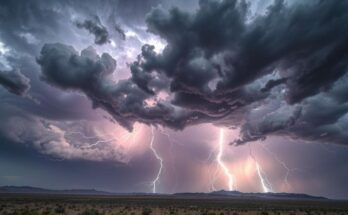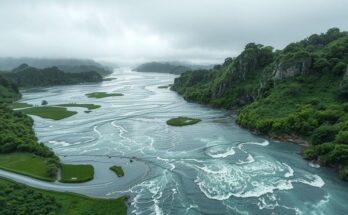Japan battles its worst wildfire in fifty years, leading to one death and evacuations of nearly 4,000 residents. The blaze, fueled by record low rainfall and high temperatures, has consumed 2,600 hectares and damaged multiple buildings. 2,000 firefighters are engaged in containment efforts, while local businesses face significant operational impacts.
Japan is currently facing its most severe wildfire crisis in half a century, with a tragic report of one fatality and the evacuation of nearly 4,000 residents. The wildfire began in the vicinity of Ofunato, propelled by unprecedented low rainfall recorded in recent weeks. Strong aerial footage highlights the white smoke emanating from forested areas, following Japan’s hottest summer on record, attributed to the broader impacts of climate change.
As of Tuesday, the wildfire has ravaged approximately 2,600 hectares (6,400 acres), which is over seven times larger than New York’s Central Park. This wildfire is now recognized as Japan’s largest since 1975 when a similar fire swept across Kushiro, burning 2,700 hectares. Reports indicate that by Sunday, at least 80 buildings had sustained damage, although a detailed assessment of the destruction is ongoing.
Efforts to contain the Ofunato wildfire include aerial operations by military and fire department helicopters; however, a city official has cautioned that there is currently no indication of the fire being under control. While weather forecasts predict snow transitioning to rain, the official expressed uncertainty about its effectiveness in suppressing the flames, citing potential challenges due to adverse conditions impeding aerial water drops.
Approximately 2,000 firefighters, primarily dispatched from regions including Tokyo, are actively engaged in both aerial and ground efforts to combat the blaze in the Iwate region, which previously suffered from a catastrophic tsunami in 2011. An evacuation advisory has been extended to roughly 4,600 residents, with 3,939 individuals having already sought refuge due to the escalating threat of the wildfire.
Historically, the number of wildfires in Japan has decreased since their peak in the 1970s. Nevertheless, the nation recorded around 1,300 wildfires in 2023, principally occurring during the months from February to April when conditions favor wildfire ignition due to dry air and high winds. In an alarming statistic, Ofunato registered only 2.5 millimeters (0.1 inches) of rainfall in February, significantly lower than the previous record low and well below the typical amounts expected for that month.
The wildfire’s impact extends beyond residents; local businesses such as Taiheiyo Cement have suspended operations due to proximity to the evacuation zone. Furthermore, confectionery company Saitoseika has expressed concerns over potential production halts, labeling the situation as “tense.” Meanwhile, Japanese baseball star Roki Sasaki has demonstrated community spirit by contributing 10 million yen ($67,000) and 500 bedding sets to assist those affected by the crisis, recalling his own past losses from the 2011 tsunami.
In summary, Japan is grappling with its most severe wildfire situation in decades, driven largely by climate change and unprecedented weather conditions. With thousands evacuated and significant destruction reported, both local authorities and residents are working valiantly to combat the flames. The interconnectedness of climate variability and human impacts becomes increasingly evident as the nation responds to this ongoing emergency.
Original Source: www.elkvalleytimes.com




